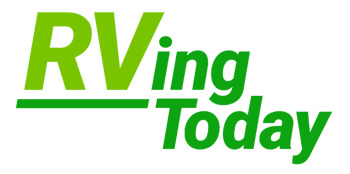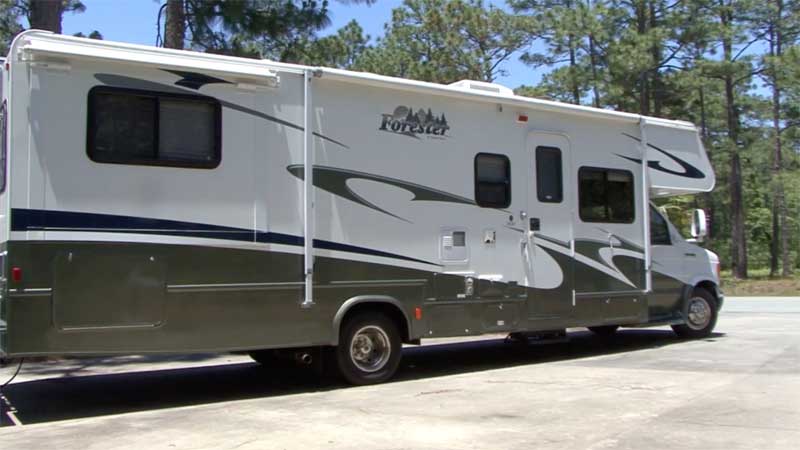Here are a few important checks to make prior to purchasing a used RV. Number one on my list is to check the RV thoroughly for water damage. Water Damage is quite common on used RVs. There are several reasons for this, but the leading cause is seams and sealants on the RV flex and move until there’s a small crack or opening that water can penetrate.
If the previous owner did not inspect and reseal these seams and sealants, chances are there’s some water damage. Another problem is water damage can be difficult to detect. All the seams and sealants on the RV roof and sidewalls need to be inspected. Indicators of leaks on the exterior are soft spots on the roof, cracked or separated sealants, and soft spots or what looks like bubbles on the sidewall of the RV, where the fiberglass delaminate from the backing. Anywhere the manufacturer cut an opening in the roof or sidewalls is prone to water leaks. On the interior of the RV, you can detect water damaged by signs of staining or discoloration, soft spots around window slide-outs, inside cabinets, or on the floor. Water damage is expensive to repair, especially if it had time to spread. I would avoid buying a used RV that has water damage. I’ve looked at many used RVs we were considering purchasing and never made it past the water damage check.
Getting past the water damage check is a good sign, and you can move on to the next item on my list, which is checking all the systems and appliances on the RV for proper operation. This check includes the water system, the LP gas system, the electrical system, and every appliance in the RV.
If you are buying it from an RV dealer and they tell you the RV will go through a predelivery inspection or “PDI,” prior to delivery, let them know you wanna know what items are included in the inspection and anything they find wrong during the inspection. If you are buying from a private owner, any inspections conducted will be on you. If you are not comfortable performing these inspections, hire a qualified RV inspector to perform the inspections for you. If, for any reason, the owner does not cooperate with any of these inspections, I would not purchase the RV. Remember, there is no warranty, and replacing almost any appliance in the RV can cost $1,000 or more. This can add up quickly.
Motorized RVs with an engine and transmission and rear axle need to be inspected too. If you’re not comfortable inspecting the driveline, try to find an RV inspector who’s qualified to do this. You want to inspect the underside for evidence of leaks. Check the condition of the belts, radiator hoses, and heater hoses. Check all of the fluid levels to make sure they are topped off and the fluid is clean. Ask the owner for maintenance records you can review. You need to drive the RV before you buy it. When you drive an RV, check the engine, transmission, and brakes, for proper operation. Turn the windshield wiper on, check the air conditioner, the heat, the radio, and other controls on the dashboard.
It is usually easy to tell if an RV was taken care of, or if it was neglected. I would avoid any RV that shows obvious signs of neglect. Do not forget the tires. It’s not uncommon for RV tires that look okay to be very old. Tires that are six years old or older need to be inspected by a tire professional. If there’s visual evidence of weather cracking or checking caused by exposure to the elements, it’s likely the tires need to be replaced. This can be expensive, especially if it’s a motor home. Make sure the used RV you’re considering meets your needs. Is it large enough or small enough? Do you like the floor-plan arrangement? Is there adequate storage inside and outside? Are there enough sleeping arrangements? Are the holding tanks large enough for the way you plan to use the RV? These are just a few considerations. Think about how you plan to use the RV and make sure the used RV you are considering to purchase fits the bill.
If it’s a travel trailer or fifth-wheel trailer, do you have the vehicle that can safely tow it? Buying another tow vehicle can be an expensive proposition. Check all of the trailer weights and make sure your tow vehicle is rated to safely tow it before you purchase the RV. If everything checks out, it’s time to discuss price. Some RV owners owe more on the RV than it’s worth. They need to pay the loan off, and they want to sell it for the payoff amount at a minimum. Don’t overpay for a used RV.
There is an RV edition to the National Automobile Dealers Association, or “NADA” guide. This is the appraisal guide most RV dealers use to determine used RV prices and values. The online NADA guide offers low retail and average retail pricing on used RVs. Prices in the guide assumes everything on the RV works as it should, and the RV is in good shape. I always tell people you wouldn’t buy a new RV for full retail price, so you shouldn’t pay full retail price for a used RV. Ask what the price is and try to negotiate the price closer to the low retail price in the NADA guide.
If the RV needs new tires or other repairs, asked if the seller is willing to replace the tires and make the repairs or lower the selling price so you can purchase new tires and make the repairs.
If everything on the RV works properly and you can get the price somewhere between low and average retail, it’s probably a fair deal for both you and the seller.
Happy camping.
Mark Polk with RV Education 101.
To learn more about how to use your RV,
Happy RV Learning,
Mark Polk, your trusted source for RV education


